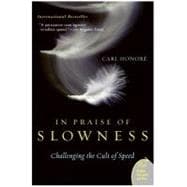About This Book
In Praise of Slowness: Challenging the Cult of Speed
By Carl Honore
Published by HarperOne, 2005
ISBN: 9780060750510
"In Praise of Slowness" is a thought-provoking book that challenges the fast-paced lifestyle we often find ourselves in. Written by Carl Honore, this book delves into the Slow Movement, which emphasizes the importance of slowing down and appreciating the simple things in life. Honore's work is not just a critique of speed but also a guide on how to approach life with a new understanding and appreciation for the value of time.
Who Uses It?
This book is primarily used by individuals interested in understanding the impact of speed on modern society. It's a valuable resource for anyone looking to slow down and appreciate the world around them. Students, professionals, and anyone interested in cultural and social movements will find this book insightful.
History and Editions
First published in 2005, "In Praise of Slowness" has been a significant contribution to the Slow Movement. The book has been widely read and discussed, influencing various aspects of modern life from work environments to personal habits. It's a foundational text that has sparked conversations about the benefits of slowing down.
Author and Other Works
Carl Honore is a British journalist and author known for his engaging writing style. In addition to "In Praise of Slowness," Honore has written other notable books such as "Under Pressure: The Call of Family in the 21st Century" and "The Art of Possibility: Transforming Professional and Personal Life." His work often explores themes of family, work-life balance, and the importance of slowing down.
Detailed Information
ISBNs and Formats
Hardcover: ISBN-13: 9780060750510
eTextbook: ISBN-13: 9780060750511 (The ebook for "In Praise of Slowness: Challenging the Cult of Speed" is available right here on eCampus.com!)
eTextbook: ISBN-13: 9780060750528 (The ebook for "In Praise of Slowness: Challenging the Cult of Speed" is available right here on eCampus.com!)
Loose-leaf: ISBN-13: 9780060750535
Rental Options: Available through eCampus.com with various rental durations
Publication Details
Publisher: HarperOne
Publication Date: 2005
Number of Pages: Varies by edition
Language: English
Other Editions and Formats
Please note that while there may be other editions or formats available, the specific details provided above are accurate for the most commonly referenced version.
Rental Options
Rental options are available through eCampus.com for all formats listed above. This ensures that students and readers can access the book in their preferred format while also considering the cost-effectiveness of renting rather than purchasing.









